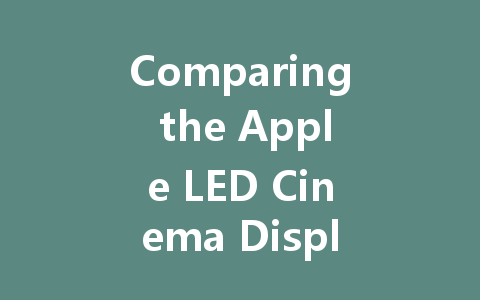
Apple has long been revered for its sleek, powerful displays that cater to creative professionals and tech enthusiasts alike. Among these, the Apple LED Cinema Display 27″ and the Thunderbolt Display have carved out a unique niche, each offering distinct features that appeal to different user preferences. In this article, we’ll explore the key differences between these two iconic displays to help you make an informed decision.
Design and Build Quality
When it comes to design, Apple is a name synonymous with elegance and functionality. Both the 27″ LED Cinema Display and the Thunderbolt Display boast a minimalist aesthetic, featuring a slim profile and an aluminum chassis that fits seamlessly into any workspace.
However, the Thunderbolt Display takes the design a step further. It also incorporates a glass front that enhances color accuracy and contrasts, providing a sleeker appearance. If aesthetics play a critical role in your choice, the Thunderbolt may win this round, although the original Cinema Display still retains a classic appeal admired by many.
Display Specifications
Let’s delve into the specifics of the display capabilities of both monitors. The Apple LED Cinema Display 27″ features a stunning resolution of 2560 x 1440 pixels, offering impressive clarity for both video and photo editing tasks. Its IPS panel technology ensures vibrant colors and wide viewing angles, making it suitable for professionals who require precision in their work.
On the other hand, the Thunderbolt Display maintains the same resolution but enhances the experience with improved brightness levels and a wide color spectrum. The brightness extends up to 375 nits compared to the Cinema Display, making it an excellent choice for those who work in significantly illuminated environments. If color accuracy and brightness are paramount for your projects, the Thunderbolt Display may be the better option.
Connectivity Options
Connectivity is a crucial aspect to consider when investing in a display, and this is where the Thunderbolt Display edges ahead. The original LED Cinema Display connects via a Mini DisplayPort, while the Thunderbolt Display utilizes the Thunderbolt connection. This technological upgrade not only allows for faster data transfer rates but also enables users to daisy chain multiple Thunderbolt devices seamlessly, which can significantly enhance productivity.
Both displays, however, come equipped with built-in USB ports, but the Thunderbolt Display offers three USB ports compared to the Cinema Display’s two. This can be particularly beneficial for users who need to connect multiple peripherals.
Audio and Camera Features
Audio and camera capabilities can often be overlooked in display comparisons, yet they are essential for video conferencing and multimedia tasks. The Apple LED Cinema Display 27″ features built-in speakers, which provide decent sound quality for general use.
The Thunderbolt Display, however, comes with enhanced audio performance, incorporating a higher-quality audio system along with a built-in FaceTime HD camera. This adds another layer of functionality, particularly for those who engage in regular video calls. Therefore, if you often utilize video conferencing tools, the Thunderbolt Display may cater to your needs more effectively.
Compatibility and Performance
Both displays are designed to work harmoniously with Apple products, but you may notice a difference when it comes to compatibility with newer Mac models. The Thunderbolt Display is optimized for use with Thunderbolt-enabled Macs, ensuring that users can access all features without any issues. In contrast, the LED Cinema Display, while still functional, may not support some of the advanced features available in newer devices.
From a performance standpoint, users report that the Thunderbolt Display also delivers better overall performance when handling graphic-intensive tasks, thanks to its more advanced connection technology. This can be particularly beneficial for video editors, graphic designers, and other professionals who rely heavily on their display’s capabilities.
Price and Availability
Pricing is always a critical consideration when shopping for tech equipment. The LED Cinema Display 27″ has been discontinued, which can sometimes make finding a new unit challenging; however, it may still be available through third-party sellers at a reduced price.
The Thunderbolt Display, though also discontinued, was priced higher at launch due to its advanced technology. If you find a new Thunderbolt model, expect to pay a premium for its modern features and enhancements.
Conclusion
When comparing the Apple LED Cinema Display 27″ and the Thunderbolt Display, it becomes clear that both serve specific preferences and use cases. The LED Cinema Display offers a classic design and reliable performance for everyday tasks, making it a suitable choice for casual users or those on a budget.
Meanwhile, the Thunderbolt Display provides superior connectivity, enhanced audio and camera features, and superior brightness and color accuracy, catering to creative professionals who require precise functionality. Ultimately, your decision will likely depend on your specific needs, budget, and aesthetic preferences.
Whether you’re choosing the classic charm of the LED Cinema Display or the modern functionality of the Thunderbolt, both displays offer excellent quality that remains a testament to Apple’s focus on innovation and design.